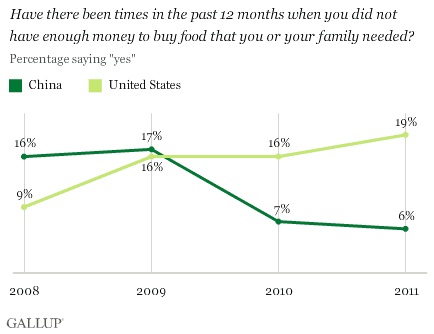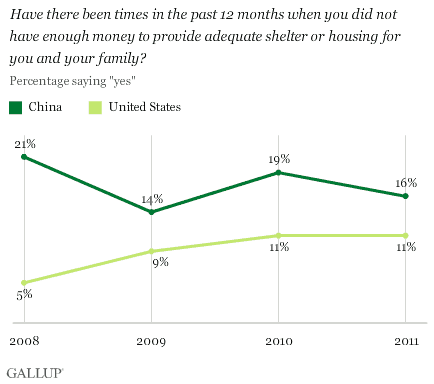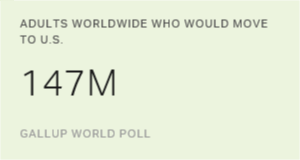WASHINGTON, D.C.-- Gallup surveys in China and the U.S. reveal Chinese are struggling less than Americans to put food on their tables. Six percent of Chinese in 2011 say there have been times in the past 12 months when they did not have enough money to buy food that they or their family needed, down significantly from 16% in 2008. Over the same period, the percentage of Americans saying they did not have money for food in the previous 12 months more than doubled from 9% in 2008 to 19% in 2011.

Chinese are also struggling less to afford adequate shelter. Sixteen percent of Chinese say in 2011 there have been times in the past 12 months when they did not have enough money to provide adequate shelter or housing for themselves and their families. This marks considerable progress since 2008, when 21% of Chinese had trouble providing shelter.
Fewer Americans are struggling with housing costs than Chinese, but the number of Americans who are struggling is increasing. Eleven percent of Americans say there have been times in the past 12 months when they could not afford adequate housing, up from 5% in 2008.

Bottom Line
Since the financial crisis began in 2008, more Americans have struggled to buy the food and shelter they and their families need. In China, on the other hand, fewer are struggling despite a slight slowdown in the country's economic growth.
Key behavioral metrics such as having enough food and adequate shelter are important for leaders to track, Gallup Chairman Jim Clifton writes in his new book, The Coming Jobs War, "not only because they occur before job and GDP growth … but also because without these basic requirements, the populace doesn't have the energy to solve its everyday problems."
Survey Methods
Results are based on telephone and face-to-face interviews with approximately 4,100 adults in China and approximately 1,000 adults in the U.S., aged 15 and older, conducted each year from 2007 to 2011. For results based on the total sample of national adults, one can say with 95% confidence that the maximum margin of sampling error ranged from ±2.1 to ±4.1 percentage points. In addition to sampling error, question wording and practical difficulties in conducting surveys can introduce error or bias into the findings of public opinion polls.
For complete methodology and specific survey dates, please review Gallup's Country Data Set details.
Learn more about how the Gallup World Poll works.
